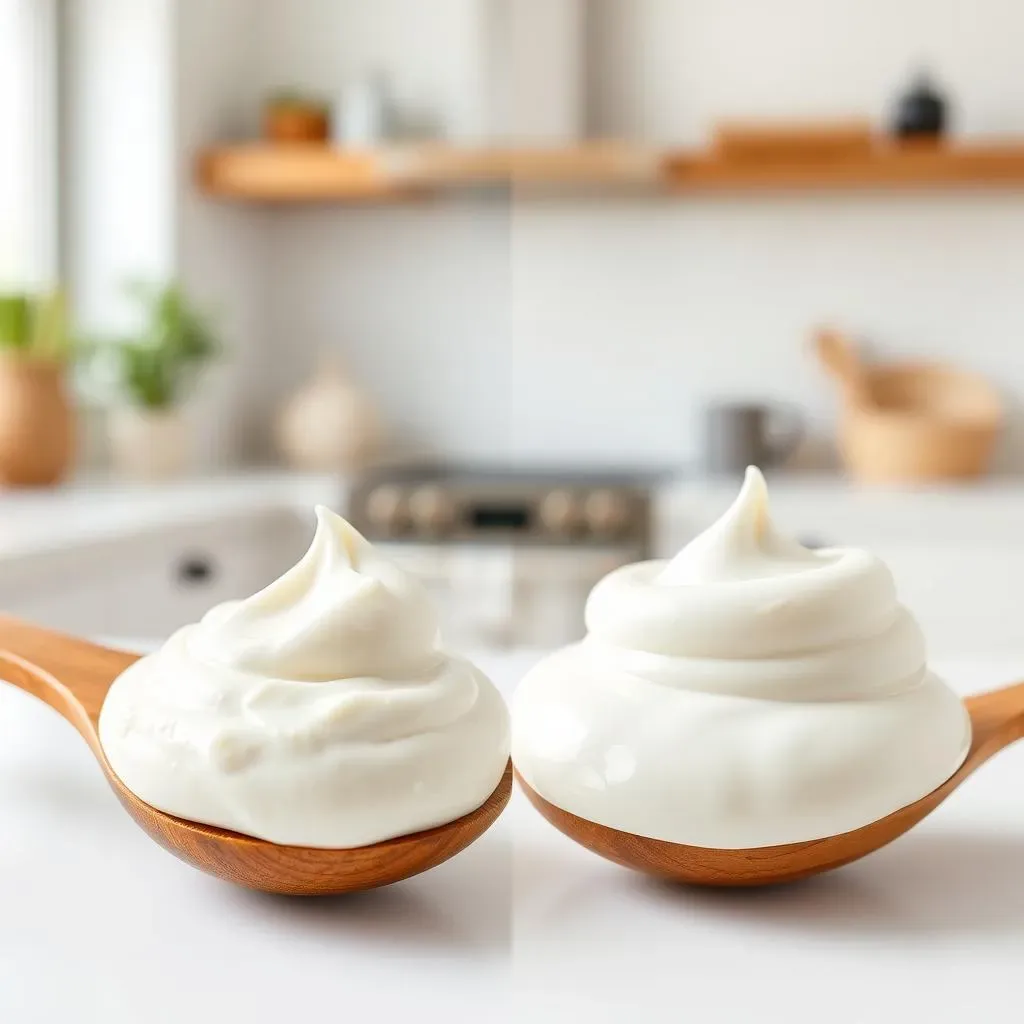Table of Contents
Ever stared blankly at a recipe, realizing you're missing a key ingredient—sour cream? Don't panic! We're tackling the burning question: "can I substitute yogurt for sour cream in a recipe?" This article isn't just about a simple yes or no. We'll explore the subtle differences between these dairy delights, examining how their distinct flavors and textures impact your baking and cooking. First, we'll conduct a taste test, comparing the tang and creaminess of yogurt and sour cream. Then, we'll dive into the world of baking, offering practical tips and tricks for successfully substituting yogurt in your favorite cakes, muffins, and breads. Finally, we'll explore the possibilities of using yogurt in savory dishes, from creamy sauces to tangy dips. Get ready to discover whether yogurt can truly stand in for sour cream, and learn how to achieve the best results, whatever your recipe demands!
Yogurt vs. Sour Cream: A Taste Test

Yogurt vs. Sour Cream: A Taste Test
Yogurt vs. Sour Cream: A Taste Test
Let's get down to the nitty-gritty: how do yogurt and sour cream actually taste? Sour cream boasts a distinctly tangy flavor, a creamy texture, and a higher fat content. Think of it as the rich, decadent cousin of yogurt. It's often used to add a luxurious touch to dips, sauces, and baked goods. You can learn more about sour cream substitutes here: sour cream substitutes.
Yogurt, on the other hand, offers a broader spectrum of flavors and textures depending on the type. Plain yogurt provides a milder tang, sometimes even a bit sweet, and a thinner consistency than sour cream. Greek yogurt, however, is a different beast entirely. Its thicker texture and more concentrated flavor make it a closer match to sour cream. For instance, if you're aiming for a creamy cheesecake, Greek yogurt might be your best bet. Want to know more about using Greek yogurt in cheesecake? Check out this guide: Greek yogurt in cheesecake.
Characteristic | Sour Cream | Plain Yogurt | Greek Yogurt |
|---|---|---|---|
Flavor | Tangy, sharp | Mildly tangy | Tangy, more concentrated |
Texture | Thick, creamy | Thin, smooth | Thick, creamy |
Fat Content | High | Low to moderate | Moderate to high |
The key takeaway here? While both offer a tangy element, sour cream's richness and thickness can't always be replicated by plain yogurt. Greek yogurt, however, often hits the mark much better, especially in recipes where texture is paramount. Consider the specific needs of your recipe. A creamy sauce might need the richness of sour cream, while a lighter baked good might benefit from yogurt's tang and moisture.
Think of it like this: sour cream is a velvety smooth jazz solo, while plain yogurt is a catchy pop tune. Greek yogurt? That's more like a soulful blues riff – it has the tang and the body, but with its own distinct character. For a deeper dive into other sour cream alternatives, check out this comprehensive guide: Cream cheese as a substitute?.
- Taste test both sour cream and different types of yogurt (plain, Greek).
- Note the differences in tanginess, creaminess, and thickness.
- Consider these differences when deciding on a substitution.
Baking with Yogurt Instead of Sour Cream: A Baker's Guide

Baking with Yogurt Instead of Sour Cream: A Baker's Guide
So, you're ready to swap sour cream for yogurt in your baking? Fantastic! It's often a surprisingly successful substitution, especially with Greek yogurt. Remember, though, that yogurt is generally thinner and less fatty than sour cream, which means you might need to adjust your recipe slightly. For instance, you might need to add a little extra flour to compensate for the extra moisture yogurt brings. Need some ideas for baking with sour cream? Check out this guide: Baking with sour cream.
One thing to keep in mind is the flavor profile. Sour cream has a sharper tang, while plain yogurt is milder. Greek yogurt tends to fall somewhere in between. If your recipe relies heavily on the sour cream’s tang, you might consider adding a squeeze of lemon juice or a dash of vinegar to your yogurt to boost its acidity. This can help mimic sour cream's flavor profile more closely. For more tips on substituting in baking, check this out: Sour cream for yogurt in baking.
- Start with a 1:1 substitution of Greek yogurt for sour cream.
- Add a little extra flour if the batter seems too thin.
- Consider adding lemon juice or vinegar to enhance the tang.
Let's talk about muffins. Muffins often benefit from the moisture yogurt provides, resulting in tender, moist crumb. The slightly tangy flavor of yogurt can also complement many muffin flavors, such as blueberry, banana, or cornbread. However, for recipes that call for a very rich, dense texture, you might find that the yogurt substitution doesn't quite deliver the same results. You might want to explore other options in that case. Looking for buttermilk substitutes? Check out this article: Buttermilk substitutes.
Cakes are another story entirely. The success of substituting yogurt in cakes depends heavily on the recipe. Some recipes, particularly those with a lighter texture, can handle the substitution well, while others might require more significant adjustments. If you're dealing with a very delicate cake recipe, it's often best to stick with the original ingredients. However, for denser cakes, experimenting with Greek yogurt might yield pleasant surprises! Thinking about using sour cream in other recipes? Check out this guide: Sour cream substitutes.
Baked Good | Yogurt Substitution Success | Notes |
|---|---|---|
Muffins | Generally successful | May increase moisture |
Cakes | Variable, depends on recipe | May require adjustments |
Cookies | Less successful | May alter texture and flavor significantly |
Savory Dishes: Swapping Sour Cream for Yogurt

Savory Dishes: Swapping Sour Cream for Yogurt
Dips and Spreads: A Creamy Transformation
Let's talk dips! Sour cream is a classic base for creamy dips, but yogurt can easily step in. Think about your favorite spinach and artichoke dip. Swapping in Greek yogurt for the sour cream often results in a lighter, tangier version. You might need to adjust seasonings slightly—a pinch more salt or garlic powder might do the trick. The thicker texture of Greek yogurt holds its own remarkably well, providing a satisfyingly creamy mouthfeel. For more ideas on sour cream substitutes, check out this guide: Sour cream substitutes.
Similarly, French onion dip transforms beautifully with a Greek yogurt base. The tanginess of the yogurt complements the sweetness of the caramelized onions. However, if your recipe calls for a very rich, decadent dip, you might find that the yogurt version is slightly lighter. In those cases, consider adding a dollop of mayonnaise or crème fraîche to boost the richness. Want to know more about using crème fraîche? Check out: Sour cream for crème fraîche?
- Use Greek yogurt as a 1:1 replacement for sour cream in dips.
- Adjust seasonings as needed to compensate for flavor differences.
- Add mayonnaise or crème fraîche for extra richness if desired.
Sauces and Dressings: A Lighter Touch
Moving on to sauces, yogurt’s versatility shines. Many creamy sauces, especially those with a lighter profile, benefit from a yogurt swap. Think of a creamy dill sauce for fish or a tzatziki for grilled meats. Plain yogurt can work well, or you can use Greek yogurt for a thicker, richer sauce. The tang of yogurt can add a nice brightness to these dishes. For example, in a creamy tomato sauce, yogurt can provide a surprising depth of flavor. Want to explore more sour cream substitutes? Check this guide out: Sour cream substitutes.
However, be mindful of the heat sensitivity of yogurt. Avoid adding yogurt directly to very hot dishes, as it can curdle. Instead, incorporate it towards the end of cooking, once the sauce has cooled slightly. This ensures a smooth, creamy consistency. For more specific guidance on substitutions, have a look at this article: Greek yogurt in stroganoff.
Sauce Type | Yogurt Recommendation | Notes |
|---|---|---|
Creamy Dill Sauce | Plain or Greek | Adds brightness |
Tzatziki | Greek | Thicker, richer texture |
Tomato Sauce | Plain | Adds depth of flavor |
Beyond the Basics: Unexpected Yogurt Uses
Don't limit yourself to the obvious swaps! Yogurt’s mild tang and creamy texture make it a surprisingly versatile ingredient in savory dishes. Consider using it in place of sour cream in potato salad for a lighter, tangier twist. The yogurt's acidity can help balance the richness of the potatoes. You can even experiment with different flavored yogurts, like lemon or herb, to add unique flavors. For more ideas on using sour cream, check this out: Sour cream substitutes.
Similarly, think about adding plain yogurt to your next batch of chili. It can add a subtle creaminess and tang that cuts through the richness of the meat and beans. Just remember to stir it in gently at the end of cooking to avoid curdling. The possibilities are truly endless; a little experimentation can go a long way. If you're looking for more substitutions, check this article: Cottage cheese substitutes.
- Experiment with different flavored yogurts to add unique flavors to dishes.
- Incorporate yogurt into dishes like potato salad or chili for a unique twist.
- Remember to add yogurt at the end of cooking to prevent curdling.